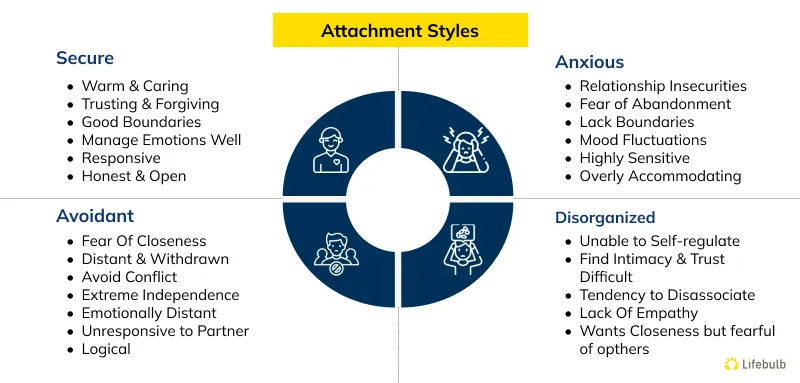Trust and communication are the backbone of any BDSM dynamic, but how we connect, express needs, and handle conflict is deeply influenced by our attachment styles. Whether you’re secure, anxious, avoidant, or somewhere in between, your attachment patterns can shape everything from scene negotiations to aftercare expectations. Understanding these dynamics helps both Tops and Bottoms navigate relationships with more empathy and intention.
This guide explores how attachment styles in BDSM show up, how they influence interactions, and how to create more secure, fulfilling connections. Whether you’re learning about attachment theory for the first time or looking for practical ways to balance different styles in a BDSM relationship, this post will help you approach your dynamic with greater awareness and care.
Understanding Attachment Styles in BDSM Relationships

Attachment theory explains how people form and maintain emotional connections, often shaped by early life experiences. These patterns influence how we handle intimacy, conflict, and security in all relationships—including BDSM dynamics. Recognizing your attachment style, as well as your partner’s, can help you navigate power exchanges, aftercare, and emotional needs with greater awareness.
The Four Main Attachment Styles
All attachment styles in BDSM present unique strengths and challenges in relationships. Knowing how these styles manifest can provide insight into how you and your partner interact in scenes and beyond.
Secure Attachment
People with a secure attachment style tend to communicate openly, feel comfortable with both closeness and independence, and manage conflict in a balanced way. In BDSM, they often find it easier to negotiate boundaries, trust their partners, and handle emotional ups and downs.
Anxious Attachment
Those with an anxious attachment style crave reassurance and may struggle with fear of abandonment. In BDSM, this might show up as seeking constant validation, struggling with debriefing after a scene, or feeling distressed when a partner needs space.
Avoidant Attachment
People with avoidant attachment value independence and may feel overwhelmed by too much emotional closeness. In a BDSM context, they might avoid deep aftercare, struggle with vulnerability, or feel more comfortable in casual dynamics rather than deeply bonded ones.
Disorganized Attachment
A mix of anxious and avoidant tendencies, this attachment style can create uncertainty in relationships. Someone with a disorganized attachment might crave intimacy but also fear it, leading to push-pull dynamics in BDSM.
Understanding your attachment style isn’t about labeling yourself or your partner. It’s a tool for building stronger relationships by recognizing patterns and learning how to support each other’s emotional needs.
How Attachment Styles Affect BDSM Dynamics
Your attachment styles in BDSM influence how you approach trust, power exchange, and emotional safety. It can shape everything from how you negotiate scenes to how you experience aftercare. By understanding these influences, you and your partner can create a more fulfilling and supportive dynamic.
Secure Attachment in BDSM
People with a secure attachment style typically thrive in BDSM because they communicate effectively, trust their partners, and manage emotions well. They are comfortable with both intimacy and autonomy, which allows for flexibility in dynamics.
How It Shows Up in BDSM
- Easily negotiates boundaries and expectations.
- Feels confident in both dominance and submission.
- Recovers quickly if a scene doesn’t go as planned.
- Provides and accepts aftercare without insecurity.
Potential Challenges
- May struggle to understand partners with anxious or avoidant tendencies.
- Can overlook emotional nuances if a partner requires more reassurance.
Anxious Attachment in BDSM
Those with an anxious attachment style tend to seek reassurance and validation. In BDSM, this can manifest as needing constant check-ins, struggling with debriefing, or fearing rejection if a partner takes space after play.
How It Shows Up in BDSM
- Craves strong emotional connections with partners.
- May become distressed if a scene doesn’t go as expected.
- Seeks frequent verbal affirmations and reassurance.
- Prefers structured aftercare with clear emotional support.
Potential Challenges
- May overanalyze a partner’s behavior post-scene.
- Can struggle with boundaries if fearing disconnection.
- Might find casual or no-strings dynamics difficult.
Avoidant Attachment in BDSM
People with an avoidant attachment style value independence and can feel overwhelmed by emotional closeness. In BDSM, they may gravitate toward dynamics that focus on physical play rather than deep emotional connection.
How It Shows Up in BDSM
- Enjoys high-intensity play but may avoid emotional vulnerability.
- Prefers less structured aftercare or time alone after scenes.
- May downplay their own emotional needs or struggle with dependency.
Potential Challenges
- Can unintentionally make anxious partners feel rejected.
- Might avoid processing emotional experiences after a scene.
- May struggle with long-term, emotionally intense dynamics.
Disorganized Attachment in BDSM
Those with a disorganized attachment style experience a mix of anxious and avoidant traits, leading to emotional contradictions. They may crave intimacy but also fear it, resulting in unpredictability in BDSM relationships.
How It Shows Up in BDSM
- Experiences cycles of emotional closeness and withdrawal.
- Can feel deeply connected during a scene but pull away afterward.
- Might struggle with trusting partners fully.
Potential Challenges
- Inconsistent emotional needs can be confusing for partners.
- May struggle with self-regulation and feeling secure in dynamics.
- Can find it hard to establish long-term BDSM relationships.
Strategies for Handling Mismatched Attachment Styles in BDSM
When partners in a dynamic have different attachment styles in BDSM, misunderstandings and emotional mismatches can arise. The key to maintaining a healthy relationship, whether casual or deeply bonded, is recognizing these differences and finding ways to meet each other’s needs while respecting boundaries.
Communication is Key
Open, honest communication is the foundation of any BDSM relationship, but it’s especially important when attachment styles don’t naturally align.
Strategies for Stronger Communication
- Be upfront about emotional needs during scene negotiations.
- Use check-ins before, during, and after play to ensure both partners feel secure.
- Encourage direct and compassionate conversations about discomfort or concerns.
- Adjust the frequency and type of communication based on each partner’s needs.
For example, a submissive with an anxious attachment might need regular reassurance, while a Dominant with avoidant tendencies might need space after a scene. Finding a middle ground—such as a short check-in followed by a period of alone time—can help both partners feel respected.
Customizing Aftercare to Meet Both Partners’ Needs
Aftercare plays a critical role in emotional regulation after BDSM scenes. Different attachment styles in BDSM often require different types of aftercare, so tailoring the experience is essential for trust and satisfaction.
Ways to Adapt Aftercare
- Anxious partners may need extended aftercare, verbal reassurance, and follow-up check-ins the next day.
- Avoidant partners may prefer shorter, low-contact aftercare and more space post-scene.
- Disorganized partners may need flexible aftercare, depending on how they feel in the moment.
- Secure partners should take the lead in ensuring their partner’s needs are met without feeling overwhelmed.
Discussing aftercare preferences ahead of time allows both partners to feel seen and supported, reducing potential misunderstandings.
Managing Conflict Based on Attachment Styles
Disagreements in BDSM relationships often stem from attachment-driven responses. Recognizing these patterns can prevent unnecessary conflict and promote healthier discussions.
Conflict Resolution Strategies
- For Anxious-Avoidant Dynamics: The anxious partner should practice self-soothing, while the avoidant partner should lean into connection rather than withdrawing.
- For Secure-Anxious Pairings: The secure partner can offer calm reassurance without overextending emotional labor.
- For Secure-Avoidant Pairings: The secure partner can encourage open conversations while respecting the avoidant partner’s need for space.
- For Disorganized Attachment: Encouraging structured conversations about emotional needs can reduce unpredictability and create stability.
By understanding how each attachment style handles conflict, partners can approach disagreements with empathy rather than defensiveness.
Practical Exercises to Strengthen BDSM Relationships Despite Attachment Differences
Understanding attachment styles in BDSM is just the first step. Taking action to strengthen your dynamic, whether through communication exercises, structured check-ins, or intentional aftercare, helps create a more secure and fulfilling connection.
Scene Negotiation with Attachment Awareness
Before engaging in a scene, use these prompts to discuss emotional needs and attachment preferences with your partner:
- How do you typically process emotions after a scene?
- What type of aftercare makes you feel most supported?
- How do you like to handle misunderstandings or conflicts?
- What can I do to help you feel more secure in this dynamic?
By integrating attachment-awareness into scene negotiation, partners can proactively prevent emotional disconnects.
Secure Attachment Building Practices
Regardless of your natural attachment tendencies, you can work toward a more secure dynamic with these habits:
- Regular Emotional Check-Ins: Have conversations outside of play where both partners express needs and boundaries.
- Intentional Aftercare Adjustments: Create a balance between reassurance and independence, meeting in the middle when attachment needs differ.
- Conflict Resolution Rituals: Establish a structured way to discuss concerns, such as setting aside dedicated time post-scene for open discussion.
These practices help build trust and resilience, making attachment styles in BDSM relationships more adaptable to different needs.
Conclusion – Creating Secure and Fulfilling BDSM Relationships
Attachment styles in BDSM influence how we engage in these relationships, from negotiating boundaries to experiencing aftercare. Whether you and your partner have similar or mismatched styles, the key to a thriving BDSM relationship is awareness, communication, and flexibility.
By recognizing attachment-driven responses, customizing communication, and adjusting aftercare practices, you can build trust and deepen your connection. No attachment styles in BDSM are “wrong” —what matters is how partners work together to create a secure, fulfilling dynamic that honors both emotional and physical needs.
With patience and understanding, BDSM relationships can evolve into deeply connected, trust-filled partnerships, no matter the attachment differences.






